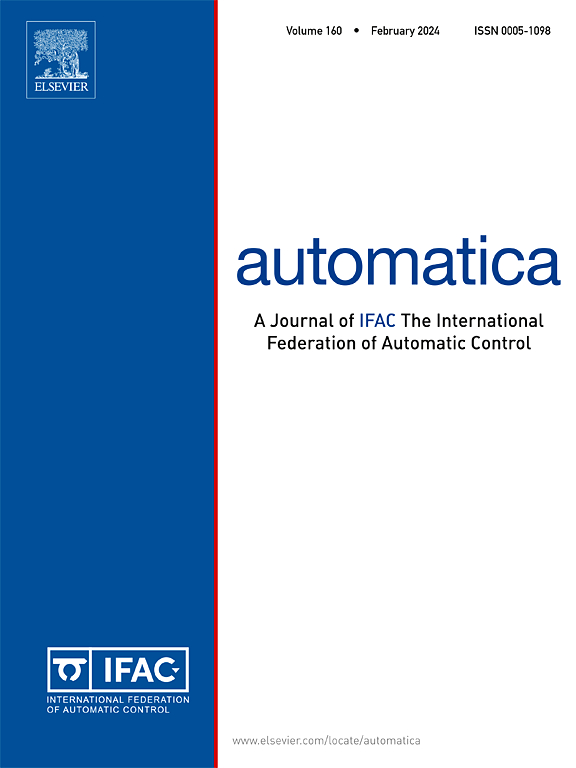C2TE:有序柔性多车排合并协调约束任务执行设计
IF 5.9
2区 计算机科学
Q1 AUTOMATION & CONTROL SYSTEMS
引用次数: 0
摘要
本文提出了一种分布式协调约束任务执行(C2TE)算法,该算法能使不同车道的车辆协同合并成一个排序灵活的队列,在期望车道上进行机动。在这种情况下,车队是灵活的,因为车辆的特定空间顺序顺序是不确定的。为了获得这样的柔性排,我们首先将多车排合并任务分为预合并调节和有序柔性排合并两个阶段,然后将其表述为基于分布式约束的优化问题。特别是,将纵向距离调节和同车道避撞子任务编码到相应的控制障碍函数(CBF)约束中,该算法可以安全地扩大相邻车辆之间足够的纵向距离。然后,将横向收敛、纵向目标吸引和相邻避撞子任务编码到CBF约束中,有效地实现了第二阶段的有序柔性排。注意,排序柔性排是通过纵向目标吸引约束和时变相邻避碰约束同时相互作用来实现的。在柔性序引起的强非线性耦合下,给出了可行性保证和严格的收敛性分析。最后,利用三辆自主移动车辆(amv)进行了实验,验证了该算法的有效性和灵活性,并进行了大量仿真,分别验证了该算法在处理车辆突然故障、新出现、不同车道数、混合自主和大规模场景时的鲁棒性、适应性和可扩展性。本文章由计算机程序翻译,如有差异,请以英文原文为准。
C2TE: Coordinated constrained task execution design for ordering-flexible multi-vehicle platoon merging
In this paper, we propose a distributed coordinated constrained task execution (C2TE) algorithm that enables a team of vehicles from different lanes to cooperatively merge into an ordering-flexible platoon maneuvering on the desired lane. Therein, the platoon is flexible in the sense that no specific spatial ordering sequences of vehicles are predetermined. To attain such a flexible platoon, we first separate the multi-vehicle platoon (MVP) merging mission into two stages, namely, pre-merging regulation and ordering-flexible platoon merging, and then formulate them into distributed constraint-based optimization problems. Particularly, by encoding longitudinal-distance regulation and same-lane collision avoidance subtasks into the corresponding control barrier function (CBF) constraints, the proposed algorithm in Stage 1 can safely enlarge sufficient longitudinal distances among adjacent vehicles. Then, by encoding lateral convergence, longitudinal-target attraction, and neighboring collision avoidance subtasks into CBF constraints, the proposed algorithm in Stage 2 can efficiently achieve the ordering-flexible platoon. Note that the ordering-flexible platoon is realized through the interaction of the longitudinal-target attraction and time-varying neighboring collision avoidance constraints simultaneously. Feasibility guarantee and rigorous convergence analysis are both provided under strong nonlinear couplings induced by flexible orderings. Finally, experiments using three autonomous mobile vehicles (AMVs) are conducted to verify the effectiveness and flexibility of the proposed algorithm, and extensive simulations are performed to demonstrate its robustness, adaptability, and scalability when tackling vehicles’ sudden breakdown, new appearing, different number of lanes, mixed autonomy, and large-scale scenarios, respectively.
求助全文
通过发布文献求助,成功后即可免费获取论文全文。
去求助
来源期刊

Automatica
工程技术-工程:电子与电气
CiteScore
10.70
自引率
7.80%
发文量
617
审稿时长
5 months
期刊介绍:
Automatica is a leading archival publication in the field of systems and control. The field encompasses today a broad set of areas and topics, and is thriving not only within itself but also in terms of its impact on other fields, such as communications, computers, biology, energy and economics. Since its inception in 1963, Automatica has kept abreast with the evolution of the field over the years, and has emerged as a leading publication driving the trends in the field.
After being founded in 1963, Automatica became a journal of the International Federation of Automatic Control (IFAC) in 1969. It features a characteristic blend of theoretical and applied papers of archival, lasting value, reporting cutting edge research results by authors across the globe. It features articles in distinct categories, including regular, brief and survey papers, technical communiqués, correspondence items, as well as reviews on published books of interest to the readership. It occasionally publishes special issues on emerging new topics or established mature topics of interest to a broad audience.
Automatica solicits original high-quality contributions in all the categories listed above, and in all areas of systems and control interpreted in a broad sense and evolving constantly. They may be submitted directly to a subject editor or to the Editor-in-Chief if not sure about the subject area. Editorial procedures in place assure careful, fair, and prompt handling of all submitted articles. Accepted papers appear in the journal in the shortest time feasible given production time constraints.
 求助内容:
求助内容: 应助结果提醒方式:
应助结果提醒方式:


